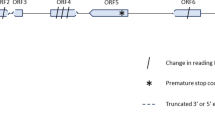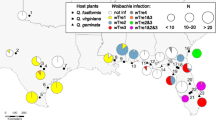Abstract
Lateral gene transfer is any process in which an organism incorporates genetic material from a phylogenetically distant and reproductively isolated organism. A previous survey demonstrated that two Japanese populations of Monochamus alternatus Hope carried many Wolbachia genes that had been acquired by lateral gene transfer in their own genomes, but were not infected with Wolbachia. To understand the prevalence of Wolbachia infection and laterally transferred Wolbachia genes in this beetle, we performed a broader survey of natural populations covering two subspecies of M. alternatus from Japan (M. alternatus endai) and Taiwan (M. alternatus alternatus). We detected laterally transferred Wolbachia genes in all Japanese and Taiwanese populations of M. alternatus, but no Wolbachia infection in any population. In addition, we confirmed the absence of Wolbachia infection and of transferred Wolbachia genes in two Japanese populations of Monochamus saltuarius Gebler, which is a congeneric relative of M. alternatus. Our findings suggest that the Wolbachia endosymbiont as gene donor has disappeared from M. alternatus, and that the transfer of part of its genome to M. alternatus occurred in the ancestor of M. alternatus before the subspeciation event.


Similar content being viewed by others
References
Aikawa T (2011) Novel diagnosis of pine wilt disease using the DNA of the pinewood nematode — Bursaphelenchus xylophilus detection kit. Tree Forest Health 15:41–44 (in Japanese)
Aikawa T, Anbutsu H, Nikoh N, Kikuchi T, Shibata F, Fukatsu T (2009) Longicorn beetle that vectors pinewood nematode carries many Wolbachia genes on an autosome. Proc R Soc B 276:3791–3798
Andersson JO (2005) Lateral gene transfer in eukaryotes. Cell Mol Life Sci 62:1182–1197
Blaxter M (2007) Symbiont genes in host genomes: fragments with a future? Cell Host Microbe 2:211–213
Breeuwer JAJ, Stouthamer R, Burns DA, Pelletier DA, Weisburg WG, Werren JH (1992) Phylogeny of cytoplasmic incompatibility microorganisms in the parasitoid wasps genus Nasonia (Hymenoptera: Pteromalidae) based on 16S ribosomal DNA sequences. Insect Mol Biol 1:25–36
Cesari M, Marescalchi O, Francardi V, Mantovani B (2005) Taxonomy and phylogeny of European Monochamus species: first molecular and karyological data. J Zool Syst Evol Res 43:1–7
Dobson SL (2003) Reversing Wolbachia-based population replacement. Trends Parasitol 19:128–133
Dunning Hotopp JC (2011) Horizontal gene transfer between bacteria and animals. Trends Genet 27:157–163
Dunning Hotopp JC, Clark ME, Oliveira DCSG, Foster JM, Fischer P, Muñoz Torres CM, Giebel JD, Kumar N, Ishmael N, Wang S, Ingram J, Nene RV, Shepard J, Tomkins J, Richards S, Spiro DJ, Ghedin E, Slatko BE, Tettelin H, Werren JH (2007) Widespread lateral gene transfer from intracellular bacteria to multicellular eukaryotes. Science 317:1753–1756
Enda N, Makihara H (2006) Biology of the genus Monochamus, especially Japanese pine sawyer, M. alternatus (Coleoptera: Cerambycidae) (2) Bionomics of M. alternatus in East Asia. Forest Pest 55:11–21 (in Japanese)
Fenn K, Conlon C, Jones M, Quail MA, Holroyd NE, Parkhill J, Blaxter M (2006) Phylogenetic relationships of the Wolbachia of nematodes and arthropods. PLoS Pathog 2:e94
Hilgenboecker K, Hammerstein P, Schlattmann P, Telschow A, Werren JH (2008) How many species are infected with Wolbachia?—a statistical analysis of current data. FEMS Microbiol Lett 281:215–220
Hurst GDD, Jiggins FM, Schulenburg, JHGvd, Bertrand D, West SA, Goriacheva II, Zakharov IA, Werren JH, Stouthamer R, Majerus MEN (1999) Male-killing Wolbachia in two species of insect. Proc R Soc Lond B 266:735–740
Kawai M, Shoda-Kagaya E, Maehara T, Zhou Z, Lian C, Iwata R, Yamane A, Hogetsu T (2006) Genetic structure of pine sawyer Monochamus alternatus (Coleoptera: Cerambycidae) population in Northeast Asia: consequences of the spread of pine wilt disease. Environ Entomol 35:569–579
Keeling PJ, Palmer JD (2008) Horizontal gene transfer in eukaryotic evolution. Nat Rev Genet 9:605–618
Klasson L, Kambris Z, Cook PE, Walker T, Sinkins SP (2009) Horizontal gene transfer between Wolbachia and the mosquito Aedes aegypti. BMC Genom 10:33
Kondo N, Ijichi N, Shimada M, Fukatsu T (2002a) Prevailing triple infection with Wolbachia in Callosobruchus chinensis (Coleoptera: Bruchidae). Mol Ecol 11:167–180
Kondo N, Nikoh N, Ijichi N, Shimada M, Fukatsu T (2002b) Genome fragment of Wolbachia endosymbiont transferred to X chromosome of host insect. Proc Natl Acad Sci USA 99:14280–14285
Makihara H (1997) Vector insects and their life history. In: Tamura N (ed) The pine wilt disease—the review of history and recent researches. Kyobunsha, Tokyo, pp 44–64 (in Japanese)
Makihara H (2004) Two new species and a new subspecies of Japanese Cerambycidae (Coleoptera). Bull FFPRI 3:15–24
Masui S, Sasaki T, Ishikawa H (1997) groE-homologous operon of Wolbachia, an intracellular symbiont of arthropods: a new approach for their phylogeny. Zool Sci 14:701–706
Nakamura-Matori K (2008) Vector-host tree relationships and the abiotic environment. In: Zhao BG, Futai K, Sutherland JR, Takeuchi Y (eds) Pine wilt disease. Springer, Tokyo, pp 144–161
Nikoh N, Nakabachi A (2009) Aphids acquired symbiotic genes via lateral gene transfer. BMC Biol 7:12
Nikoh N, Tanaka K, Shibata F, Kondo N, Hizume M, Shimada M, Fukatsu T (2008) Wolbachia genome integrated in an insect chromosome: evolution and fate of laterally transferred endosymbiont genes. Genome Res 18:272–280
O’Neill SL, Giordano R, Colbert AME, Karr TL, Robertson HM (1992) 16S rRNA phylogenetic analysis of the bacterial endosymbionts associated with cytoplasmic incompatibility in insects. Proc Natl Acad Sci USA 89:2699–2702
Ros VID, Hurst GDD (2009) Lateral gene transfer between prokaryotes and multicellular eukaryotes: ongoing and significant? BMC Biol 7:20
Rousset F, Bouchon D, Pintureau B, Juchault P, Solignac M (1992) Wolbachia endosymbionts responsible for various alterations of sexuality in arthropods. Proc R Soc Lond B 250:91–98
Shin SC (2008) Pine wilt disease in Korea. In: Zhao BG, Futai K, Sutherland JR, Takeuchi Y (eds) Pine wilt disease. Springer, Tokyo, pp 26–32
Shoda-Kagaya E (2006) Phylogeography and population structure of the pine sawyer Monochamus alternatus. J Jpn For Soc 88:416–421 (in Japanese with English summary)
Shoda-Kagaya E (2008) Molecular ecology of vectors. In: Zhao BG, Futai K, Sutherland JR, Takeuchi Y (eds) Pine wilt disease. Springer, Tokyo, pp 184–198
Stouthamer R, Breeuwer JAJ, Luck RF, Werren JH (1993) Molecular identification of microorganisms associated with parthenogenesis. Nature 361:66–68
Stouthamer R, Breeuwer JAJ, Hurst GDD (1999) Wolbachia pipientis: microbial manipulator of arthropod reproduction. Annu Rev Microbiol 53:71–102
Togashi K (1989) Development of Monochamus alternatus Hope (Coleoptera: Cerambycidae) in relation to oviposition time. Jpn J Appl Entomol Zool 33:1–8 (in Japanese with English summary)
Togashi K (2008) Vector-nematode relationships and epidemiology in pine wilt disease. In: Zhao BG, Futai K, Sutherland JR, Takeuchi Y (eds) Pine wilt disease. Springer, Tokyo, pp 162–183
Toki W, Kubota K (2010) Molecular phylogeny based on mitochondrial genes and evolution of host plant use in the long-horned beetle tribe Lamiini (Coleoptera: Cerambycidae) in Japan. Environ Entomol 39:1336–1343
Werren JH (1997) Bology of Wolbachia. Annu Rev Entomol 42:587–609
Werren JH, Windsor DM (2000) Wolbachia infection frequencies in insects: evidence of a global equilibrium? Proc R Soc Lond B 267:1277–1285
Werren JH, Windsor D, Guo L (1995) Distribution of Wolbachia among Neotropical arthropods. Proc R Soc Lond B 262:197–204
Woolfit M, Iturbe-Ormaetxe I, McGraw EA, O’Neill SL (2009) An ancient horizontal gene transfer between mosquito and the endosymbiotic bacterium Wolbachia pipientis. Mol Biol Evol 26:367–374
Zhao BG, Futai K, Sutherland JR, Takeuchi Y (2008) Pine wilt disease. Springer, Tokyo
Zhou W, Rousset F, O’Neill S (1998) Phylogeny and PCR-based classification of Wolbachia strains using wsp gene sequences. Proc R Soc Lond B 265:509–515
Acknowledgments
We deeply thank the following researchers for help in collecting M. alternatus and M. saltuarius populations: Hajime Kosaka, Noritoshi Maehara, Eriko Kawaguchi, Seiichi Kanetani, Natsumi Kanzaki, Tadahisa Urano, Hideki Irei, Hiroshi Makihara, Shota Jikumaru, Kazuyuki Fujita, Tadao Goto, Takanori Kubono, Yu Ichihara, Toshiyuki Koiwa, Kazumi Kobayashi, Mitsuhiro Okada and Wataru Toki. The entry of the Taiwanese population of M. alternatus into Japan was permitted under special conditions by the Minister of Agriculture, Forestry and Fisheries 21Y1218. This work was supported by Grant-in-Aid for Young Scientists (A) (22688012) to TA, for Challenging Exploratory Research (23657163) to TA and HA, and for Scientific Research (C) (22570216) to NN from the Japanese Society for the Promotion of Science.
Author information
Authors and Affiliations
Corresponding author
Rights and permissions
About this article
Cite this article
Aikawa, T., Nikoh, N., Anbutsu, H. et al. Prevalence of laterally transferred Wolbachia genes in Japanese pine sawyer, Monochamus alternatus (Coleoptera: Cerambycidae). Appl Entomol Zool 49, 337–346 (2014). https://doi.org/10.1007/s13355-014-0256-0
Received:
Accepted:
Published:
Issue Date:
DOI: https://doi.org/10.1007/s13355-014-0256-0




